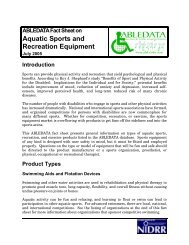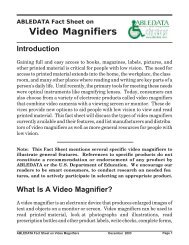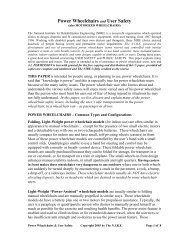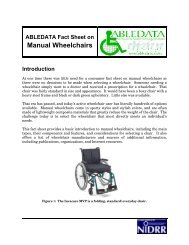Power Wheelchairs and Residential Fire Safety - AbleData
Power Wheelchairs and Residential Fire Safety - AbleData
Power Wheelchairs and Residential Fire Safety - AbleData
Create successful ePaper yourself
Turn your PDF publications into a flip-book with our unique Google optimized e-Paper software.
3) <strong>Power</strong> wheelchairs <strong>and</strong> scooters can be limited to the safer types. They should be<br />
electrically powered <strong>and</strong> have these characteristics, for maximum safety:<br />
(a) Use sealed gel type rechargeable batteries. (NO liquid electrolyte).<br />
(b) Use no-spark electronically controlled battery charger with safety cables & plugs.<br />
(c) Use wheelchair motors that are ac brushless induction motors. Avoid all brush-type<br />
motors, whether ac or dc powered, because the brushes spark.<br />
(d) The wheelchair controller should NOT have ON-OFF switches (which spark) unless<br />
they are sealed <strong>and</strong> fireproof. It should have continuously variable electronic speed &<br />
power controls.<br />
(e) Every wheelchair <strong>and</strong> scooter in a building should have fire-retardant cushions <strong>and</strong><br />
upholstery. Likewise, all beds, sofas, upholstered furniture, cushion, pillows, carpets,<br />
<strong>and</strong> curtains should be of fire-retardant material.<br />
(f) Residents <strong>and</strong> visitors should be forbidden to smoke in the buildings.<br />
(g) All areas should be equipped with approved fire- <strong>and</strong> smoke- detectors. They should<br />
also have natural gas <strong>and</strong> carbon monoxide detectors. All areas should have audible fire<br />
alarm warning systems <strong>and</strong>, if deaf people are resident, visual <strong>and</strong> vibratory alarm signals<br />
for the deaf people.<br />
(h) All rooms, apartments, offices, closets, storage areas, waste storage, utility, <strong>and</strong><br />
laundry areas should be subjected to regularly scheduled (<strong>and</strong> to occasional surprise)<br />
safety inspections, by qualified inspectors.<br />
(i) Oxygen Users may have in their living quarters, either of two types of breathing<br />
aids. (1) One type, often used by (normally mobile) people with COPD or other<br />
breathing disorders, is a room-air oxygen concentration machine. An apartment with<br />
such a machine is at increased risk for fire. The apartment should NOT have a gas heater<br />
or a gas stove because the atmosphere is much more explosive with the concentrator than<br />
without. Also, cigarettes <strong>and</strong> open flames should be avoided in such an apartment.<br />
(2) The other type oxygen device involves use of a thin plastic tube in a person’s nose,<br />
to deliver the needed oxygen. This nasal tube does NOT normally release oxygen into the<br />
apartment <strong>and</strong> should be completely safe for everyone.<br />
(j) <strong>Power</strong>ed Ventilators - or Respirators – may, when needed for life support, be in<br />
the bedroom <strong>and</strong> possibly on a powered wheelchair. In the residence, they are usually<br />
plugged into an outlet <strong>and</strong> ac-powered. On a wheelchair, they are battery powered. These<br />
are life-support devices that must be kept running <strong>and</strong> must be kept with the user, no<br />
matter what the emergency. Housing management <strong>and</strong> maintenance personnel should be<br />
aware of all residents using these devices; should have approved power backup<br />
arrangements; should evacuate these disabled people first; <strong>and</strong> should arrange for<br />
ambulances or EMT personnel to remove these residents <strong>and</strong> their ventilators quickly <strong>and</strong><br />
<strong>Power</strong> <strong>Wheelchairs</strong> & <strong>Fire</strong>-<strong>Safety</strong> Copyright 2004 by The N.I.R.E. Page 2 of 7







